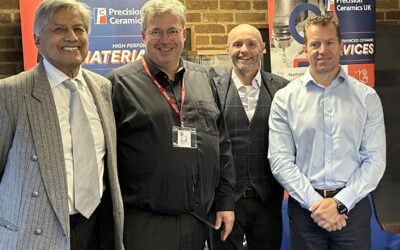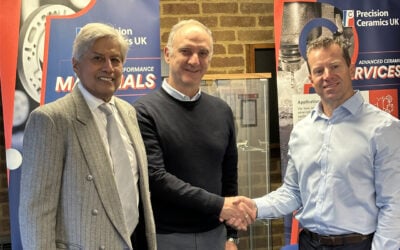Over the years there have been many great movies involving fire and water and the fantasy drama television series ‘Game of Thrones’ has done much to take two of the earth’s most natural elements to a whole new level.
Behind the scenes, fire and water provide a slightly less glamorous but still very important role in the cutting and shaping of sintered ceramics. Here, complex flat shapes can be machined without the usual straight-line constraints of diamond wheels.
FIRE in the form of an industrial laser, is now a common technology for cutting and drilling sintered sheets of alumina, aluminium nitride, and zirconia.
Initially developed for the electronics industry, where thin sheets of electrical insulation were cut, drilled, and prepared to be turned into insulators or as the base for a specific electronic device, conductive tracks and pads could easily be added at a later stage to enable precise fabrication. The laser can be programmed to repeat patterns and, as no other tooling is required, the process is still fast and efficient.
The industrial lasers we use are generally low power, which restricts the thickness of the ceramic sheets we can machine. In alumina, we can laser cut up to 0.120” thick. In aluminium nitride, which is more difficult to laser cut, as it conducts heat better than alumina, we can laser cut up to 0.85” thick. Most of these start as 4” x 4” substrates. These can be tape cast, lapped, or polished; processes which are more practical and economical to carry out before laser machining.
Thermal shock also inhibits some of the intricate features that can be achieved using an industrial laser. The plates can be cut, drilled, and scribed, but all the way through, as the localized heating caused by insufficient power in the laser or the plate being too thick, causes almost instant stress and shock.
More recent technology and lasers with increased power has allowed cutting of ceramic plates up to 0.12”, which has considerably broadened the scope of applications from electronic to structural products. The edge quality on thicker pieces can be slightly reduced but this still remains an effective process.
Lasers can also be used to mark ceramic by burning the surface of a component. This is particularly useful for product identification and traceability with part numbers and even company logos can be scribed.
WATER in the form of a high-pressure water jet, loaded with microscopic ceramic particles, typically produces a water jet of 0.040”, using a pump delivering 32,000 psi. This system was originally developed to cut metal, polymer, and fabrics and was widely used in the aerospace and garment industries.
Nowadays pressures of over 75,000 psi can be generated which are sufficient to cut a piece of 4” thick titanium in one pass.
The cutting of ceramics by water jet is limited as the hard nature of the material defeats the jet. This is not due to thermal shock as when cutting with a laser. The energy of the water simply reduces as the material is cut.
The initial impact of a water jet on the ceramic is clean and accurate but as the jet penetrates the plate, the width of the cut increases to a point where a funnel shape is generated and the process becomes ineffective.
Water jet cutting tends to be more effective with more thermally conductive ceramics and also materials such as Macor, that are softer, can be cut effectively at a thickness of 2”. Composite structures can also be cut where ceramic and other materials are machined at the same time.
Both fire and water cutting systems can be used to cut intricate flat shapes in a dress making pattern where holes and curves can be cut repeatedly with reasonable accuracy.





